Feral Hogs in Arkansas
Do you have feral hogs? Do you know how to recognize signs of feral hog damage?
Though feral hogs have been in Arkansas for centuries, in the last 20 years feral
hogs have become a major invasive pest in our forests and fields. They cost Arkansas'
producers millions of dollars each year by damaging forests and crops, and polluting
our streams and ponds. Arkansas currently has regulations governing the transportation
and release of feral hogs.
Download the Arkansas Feral Hog Handbook
Get more feral hog resources
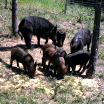 |
What is a feral hog?
- Feral hogs, feral swine, wild swine, wild pigs, wild hogs, Eurasian boars, Russian
boars, wild boars - are all the same species, Sus scrofa.
- These are the same animals that farmers raise and what we take home from the grocery
store.
-
According to Arkansas law, a domestic, pen-raised hog that escapes is considered feral
after 5 days, but if the owner notifies neighbors of its escape, it is considered
feral after 15 days.
Image: Skip Armes, University of Arkansas
Learn more about laws and regulations governing feral hogs
|
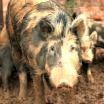 |
What does a feral hog look like?
- Feral hogs can be of any color found in domestic hog breeds, including pink, dark
brown, spotted, black with a white collar, as well as coarse black hair with bristles
along the back.
- Domestic hogs released into the wild within a few months will grow a longer, shaggier
coat.
- After a couple generations, their fur becomes darker and longer with a grizzled appearance
and an elongated snout with tusks, and young piglets are born with stripes.
Image: Clint Turnage, USDA APHIS Wildlife Services
Learn more about how to recognize feral hogs.
|
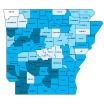 |
Where are feral hogs found in Arkansas?
- Feral hogs are in every county in Arkansas, though local population densities vary.
- Feral hogs have lived in the bottomlands of south central Arkansas for decades, if
not centuries.
- They typically live in secluded areas in thickets near creeks, streams, and rivers,
though some venture into urban areas.
- Feral hogs range over several miles if necessary in search of food and water.
- Boars range even farther in search of mates.
Find out what parts of Arkansas are infested with feral hogs.
|
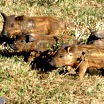 |
How quickly do feral hogs multiply?
- Feral hogs are prolific breeders with females producing 3-8 or more piglets, starting
at 6-10 months of age.
- Population growth patterns in Arkansas and other states since the 1990's suggests
feral hogs have not dispersed naturally. Indirect evidence suggests hunters released
hogs presumably to increase sport hunting opportunities.
- In Arkansas, currently it is illegal to transport, possess, sell, offer for sale,
purchase, receive, import, or distribute a live feral hog.
Image: Vladimir Dinets, University of Miami, Bugwood.org
Learn how to stop the spread of feral hogs.
|
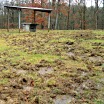 |
How do feral hogs affect you & the environment?
- Their rooting causes loss of crops and pasture lands which affects agriculture production
where our food comes from.
- Their wallowing and rooting in or near waterways causes pollution and sedimentation,
which contaminates the water we drink and swim.
- They compete with native wildlife for food including acorns, roots, tubers, and soil
invertebrates such as earthworms.
- Feral hogs are opportunistic feeders which means they eat eggs of ground nesting birds,
salamanders, frogs, toads, snakes, and even an occasional deer fawn.
Image: Craig Hicks, bugwood.org
Learn more about the environmental impact of feral hogs.
Learn more about Brucellosis carried by feral hogs.
Learn about additional diseases carried by feral hogs.
|
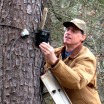 |
How do I know if I've got feral hogs?
- Typically their extensive rooting which "plows up" the soil is the first clue you've
got feral hogs. They can root up a pasture or yard overnight!
- Other signs include tracks, scat, and rub marks or tusking of trees.
- Feral hogs go nocturnal when disturbed by human activity.
- A game camera is an effective tool for determining if you have feral hogs and how
many.
Image: Becky McPeake, University of Arkansas
Learn how to recognize feral hog damage (video)
|
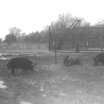 |
What can be done about feral hogs?
- USDA APHIS Wildlife Services and the Arkansas Game & Fish Commission recommend corral
trapping groups of feral hogs using specific equipment and methods.
- Typically shooting one or two feral hogs does little for population control and only
serves to educate the survivors which become more difficult to find again.
- Hunting with hog dogs may be effective for removing individual hogs which are trap-shy
and difficult to capture otherwise.
Image: Jennifer Caraway, Miller County Ag Agent
Learn how to control feral hogs on your land.
|
Feral Hog Documents
Feral Hog Control in Arkansas
Laws and Regulations Governing Feral Hogs in Arkansas
Human Brucellosis Risk from Feral Swine






